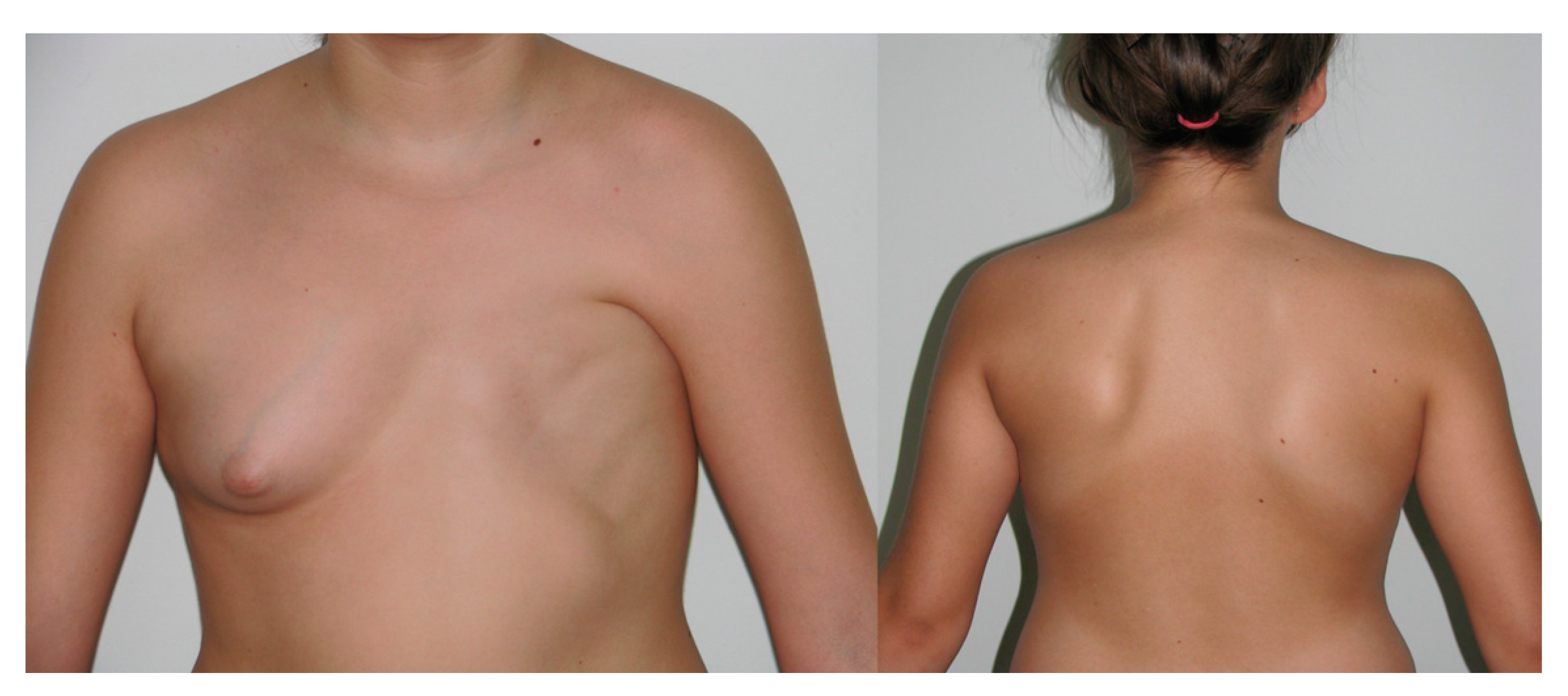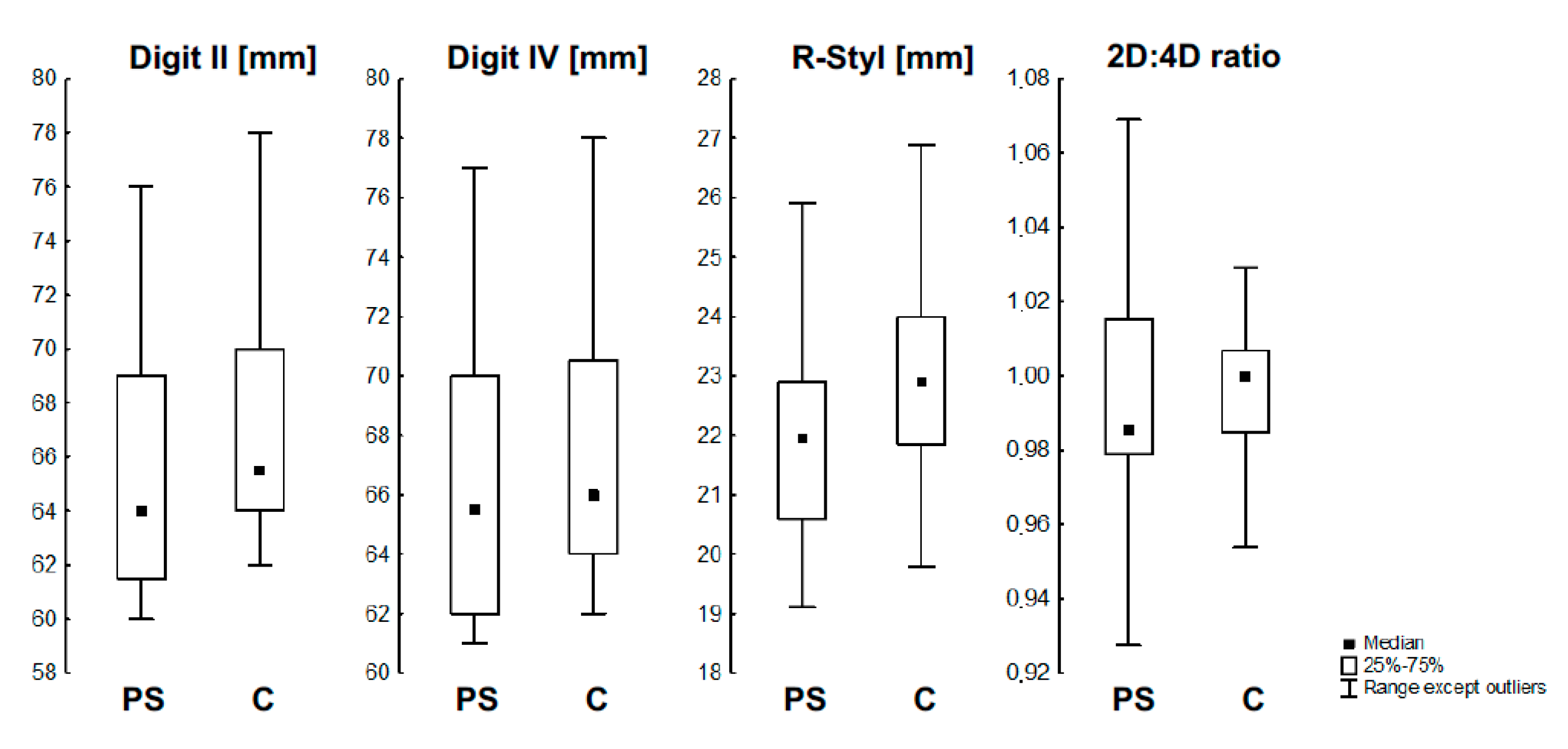Upper-Limb Disturbances in Female Patients with Poland Syndrome, including the Digit Ratio (2D:4D)
Abstract
:1. Introduction
2. Materials and Methods
3. Results
4. Discussion
5. Conclusions
Author Contributions
Funding
Institutional Review Board Statement
Informed Consent Statement
Data Availability Statement
Conflicts of Interest
References
- Yiyit, N.; Işıtmangil, T.; Öksüz, S. Clinical analysis of 113 patients with Poland syndrome. Ann. Thorac. Surg. 2015, 99, 999–1004. [Google Scholar] [CrossRef]
- Catena, N.; Divizia, M.T.; Calevo, M.G.; Baban, A.; Torre, M.; Ravazzolo, R.; Lerone, M.; Sénès, F.M. Hand and upper limb anomalies in Poland syndrome: A new proposal of classification. J. Pediatr. Orthop. 2012, 32, 727–731. [Google Scholar] [CrossRef]
- Buckwalter, V.J.A.; Shah, A.S. Presentation and Treatment of Poland Anomaly. Hand 2016, 11, 389–395. [Google Scholar] [CrossRef] [Green Version]
- Mentzel, H.-J.; Seidel, J.; Sauner, D.; Vogt, S.; Fitzek, C.; Zintl, F.; Kaiser, W.A. Radiological aspects of the Poland syndrome and implications for treatment: A case study and review. Eur. J. Pediatr. 2002, 161, 455–459. [Google Scholar] [CrossRef]
- Nachnani, J.S.; Supe, A.N. A variant of Poland syndrome. J. Postgrad. Med. 2001, 47, 131–132. [Google Scholar]
- Al-Qattan, M.M. Classification of hand anomalies in Poland’s syndrome. Br. J. Plast. Surg. 2001, 54, 132–136. [Google Scholar] [CrossRef] [PubMed]
- Ahmed, M.S.; Nwoku, A.L. Maxillomandibular deformity in association with Poland anomaly. J. Craniomaxillofac. Surg. 1997, 25, 158–161. [Google Scholar] [CrossRef] [PubMed]
- Erdogan, B.; Akoz, T.; Gorgu, M.; Kutlay, R.; Dag, F. Possibly new multiple congenital anomaly syndrome: Cranio-fronto-nasal dysplasia with Poland anomaly. Am. J. Med. Genet. 1996, 65, 222–225. [Google Scholar] [CrossRef]
- Beer, G.M. The clinical findings of a missing latissimus dorsi muscle in Poland’s syndrome. Plast. Reconstr. Surg. 1997, 99, 926–927. [Google Scholar] [CrossRef]
- Debeer, P.; Brys, P.; De Smet, L.; Fryns, J.P. Unilateral absence of the trapezius and pectoralis major muscle: A variant of Poland syndrome. Genet. Couns. 2002, 13, 449–453. [Google Scholar]
- Drever, J.M.; Zavala, J. Unilateral absence of the external oblique muscle with hypoplasia of the rectus abdominis muscle in a patient with Poland syndrome. Plast. Reconstr. Surg. 2002, 110, 1802–1803. [Google Scholar] [CrossRef]
- Bamforth, J.S.; Fabian, C.; Machin, G.; Honore, L. Poland anomaly with a limb body wall disruption defect: Case report and review. Am. J. Med. Genet. 1992, 43, 780–784. [Google Scholar] [CrossRef] [PubMed]
- Baas, M.; Burger, E.B.; Sneiders, D.; Galjaard, R.H.; Hovius, S.E.R.; van Nieuwenhoven, C.A. Controversies in Poland Syndrome: Alternative Diagnoses in Patients With Congenital Pectoral Muscle Deficiency. J. Hand Surg. Am 2018, 43, 186.e1–186.e16. [Google Scholar] [CrossRef]
- Foucras, L.; Grolleau, J.L.; Chavoin, J.P. Poland’ syndrome and hand’s malformations: About a clinic series of 37 patients. Ann. Chir. Plast. Esthet. 2005, 50, 138–145. [Google Scholar] [CrossRef]
- Minguella-Sola, J.; Cabrera-Gonzalez, M. Poland’s syndrome. A report of 38 cases. An. Esp. Pediatr. 1998, 48, 143–147. [Google Scholar]
- Al-Qattan, M.M.; Al Thunayan, A. The middle phalanx in Poland syndrome. Ann. Plast. Surg. 2005, 54, 160–164. [Google Scholar] [CrossRef]
- Ireland, D.C.; Takayama, N.; Flatt, A.E. Poland’s syndrome: A review of forty-three cases. J. Bone Jt. Surg. Am. 1976, 58, 52–58. [Google Scholar] [CrossRef]
- Senrui, H.; Egawa, T.; Horiki, A. Anatomical findings in the hand of patients with Poland’s syndrome. J. Bone Jt. Surg. Am. 1982, 64, 1079–1081. [Google Scholar] [CrossRef]
- Bavinck, J.N.; Weaver, D.D. Subclavian artery supply disruption sequence: Hypothesis of a vascular etiology for Poland, Klippel-Feil, and Mobius anomalies. Am. J. Med. Genet. 1986, 23, 903–918. [Google Scholar] [CrossRef]
- Beer, G.M.; Kompatscher, P.; Hergan, K. Poland’s syndrome and vascular malformations. Br. J. Plast. Surg. 1996, 49, 482–484. [Google Scholar] [CrossRef]
- Galvagno, G.; Marra, A.; Ghiotti, M.P.; Cattaneo, G. Poland’s syndrome. Presentation of a case of probable vascular origin. Pediatr. Med. Chir. 1988, 10, 119–121. [Google Scholar] [PubMed]
- Martinez-Frias, M.L.; Czeizel, A.E.; Rodriguez-Pinilla, E.; Bermejo, E. Smoking during pregnancy and Poland sequence: Results of a population-based registry and a case-control registry. Teratology 1999, 59, 35–38. [Google Scholar] [CrossRef]
- Puvabanditsin, S.; Garrow, E.; Augustin, G.; Titapiwatanakul, R.; Kuniyoshi, K.M. Poland-Mobius syndrome and cocaine abuse: A relook at vascular etiology. Pediatr. Neurol. 2005, 32, 285–287. [Google Scholar] [CrossRef] [PubMed]
- Rosa, R.F.M.; Travi, G.M.; Valiatti, F.; Zen, P.R.G.; Pinto, L.L.; Kiss, A.; Graziadio, C.; Paskulin, G.A. Poland syndrome associated with an aberrant subclavian artery and vascular abnormalities of the retina in a child exposed to misoprostol during pregnancy. Birth Defects Res. A Clin. Mol. Teratol. 2007, 79, 507–511. [Google Scholar] [CrossRef]
- Manning, J.T. Digit Ratio: A Pointer to Fertility, Behavior, and Health; Rutgers University Press: New Brunswick, NY, USA, 2002. [Google Scholar]
- Manning, J.T.; Scutt, D.; Wilson, J.; Lewis-Jones, D.I. The ratio of 2nd to 4th digit length: A predictor of sperm numbers and concentrations of testosterone, luteinizing hormone and oestrogen. Hum. Reprod. 1998, 13, 3000–3004. [Google Scholar] [CrossRef] [PubMed] [Green Version]
- Manning, J.T. Resolving the role of prenatal sex steroids in the development of digit ratio. Proc. Natl. Acad. Sci. USA 2011, 108, 16143–16144. [Google Scholar] [CrossRef] [Green Version]
- Vaccari, C.M.; Tassano, E.; Torre, M.; Gimelli, S.; Divizia, M.T.; Romanini, M.V.; Bossi, S.; Musante, I.; Valle, M.; Senes, F.; et al. Assessment of copy number variations in 120 patients with Poland syndrome. BMC Med. Genet. 2016, 17, 89. [Google Scholar] [CrossRef]
- Wu, F.S.; Tian, W.; Zhao, J.H.; Ma, W.; Guo, Y.; Yin, Y.B. Developmental characteristics of various types of hand bones of Poland’s syndrome. Zhonghua Wai Ke Za Zhi 2016, 54, 508–512. [Google Scholar]



| Poland Syndrome | Poland Syndrome | p | |||||||
|---|---|---|---|---|---|---|---|---|---|
| Affected Side n = 36 | Nonaffected Side n = 36 | ||||||||
| Mean | SD | Min | Max | Mean | SD | Min | Max | ||
| Digit 2 length [mm] | 61.7 | 12.4 | 31.0 | 76.0 | 67.1 | 4.2 | 62.0 | 78.0 | 0.000 |
| Digit 4 length [mm] | 62.5 | 13.2 | 29.0 | 77.0 | 67.5 | 4.2 | 62.0 | 78.0 | 0.004 |
| 2D:4D ratio | 0.99 | 0.05 | 0.88 | 1.14 | 0.99 | 0.03 | 0.91 | 1.06 | 0.197 |
| r-styr length [mm] | 22.0 | 1.9 | 19.1 | 25.9 | 23.1 | 1.7 | 19.8 | 26.9 | 0.000 |
| Poland Syndrome Affected Side n = 36 | Control Group n = 100 | p | |||||||
|---|---|---|---|---|---|---|---|---|---|
| Mean | SD | Min | Max | Mean | SD | Min | Max | ||
| Digit 2 length [mm] | 61.7 | 12.4 | 31.0 | 76.0 | 67.4 | 2.4 | 62.0 | 73.0 | 0.003 |
| Digit 4 length [mm] | 62.5 | 13.2 | 29.0 | 77.0 | 67.6 | 2.5 | 62.0 | 73.0 | 0.049 |
| 2D:4D ratio | 0.99 | 0.05 | 0.88 | 1.14 | 1.00 | 0.02 | 0.94 | 1.03 | 0.208 |
| r-styr length [mm] | 22.0 | 1.9 | 19.1 | 25.9 | 24.7 | 1.6 | 22.0 | 28.0 | 0.000 |
Publisher’s Note: MDPI stays neutral with regard to jurisdictional claims in published maps and institutional affiliations. |
© 2022 by the authors. Licensee MDPI, Basel, Switzerland. This article is an open access article distributed under the terms and conditions of the Creative Commons Attribution (CC BY) license (https://creativecommons.org/licenses/by/4.0/).
Share and Cite
Fijałkowska, M.; Koziej, M.; Antoszewski, B. Upper-Limb Disturbances in Female Patients with Poland Syndrome, including the Digit Ratio (2D:4D). J. Clin. Med. 2022, 11, 7253. https://doi.org/10.3390/jcm11247253
Fijałkowska M, Koziej M, Antoszewski B. Upper-Limb Disturbances in Female Patients with Poland Syndrome, including the Digit Ratio (2D:4D). Journal of Clinical Medicine. 2022; 11(24):7253. https://doi.org/10.3390/jcm11247253
Chicago/Turabian StyleFijałkowska, Marta, Mateusz Koziej, and Bogusław Antoszewski. 2022. "Upper-Limb Disturbances in Female Patients with Poland Syndrome, including the Digit Ratio (2D:4D)" Journal of Clinical Medicine 11, no. 24: 7253. https://doi.org/10.3390/jcm11247253





